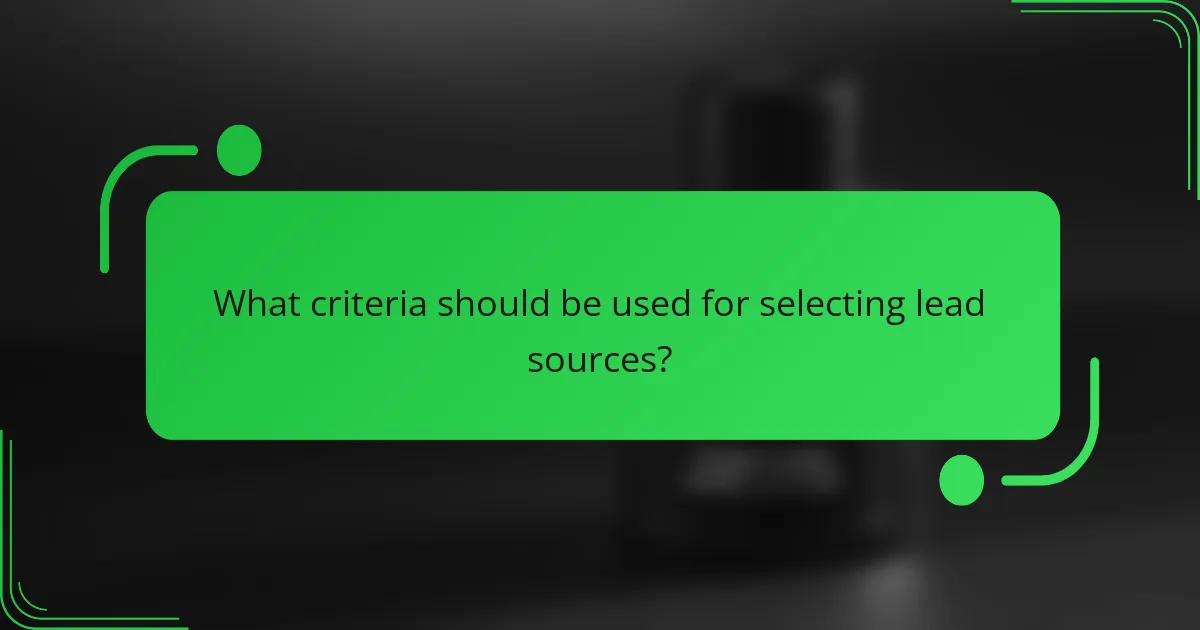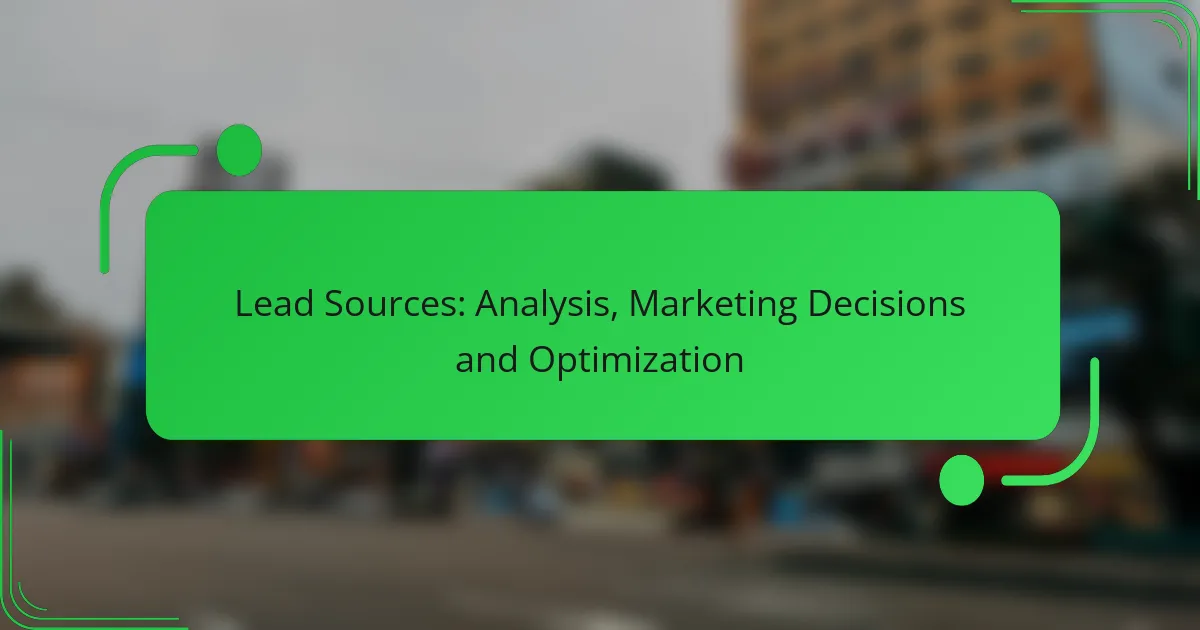In today’s competitive landscape, identifying and optimizing lead sources is crucial for business success. By leveraging a combination of online advertising, social media, and personalized marketing strategies, companies can effectively reach their target audiences. Analyzing the performance of these channels through data-driven insights enables informed marketing decisions that enhance lead generation and conversion rates.

What are the best lead sources for businesses in Canada?
The best lead sources for businesses in Canada include a mix of online advertising, social media, email marketing, content strategies, and networking events. Each source offers unique advantages and can be tailored to fit specific business goals and target audiences.
Online advertising platforms
Online advertising platforms like Google Ads and Facebook Ads are effective for generating leads quickly. These platforms allow businesses to target specific demographics and interests, ensuring that ads reach the most relevant audiences.
Consider setting a budget that aligns with your overall marketing strategy, and monitor performance metrics regularly to optimize ad spend. A/B testing different ad formats can also help identify what resonates best with potential leads.
Social media channels
Social media channels such as LinkedIn, Instagram, and Twitter are powerful tools for lead generation. They enable businesses to engage directly with their audience, share valuable content, and promote products or services.
Utilize organic posts and paid promotions to maximize reach. Regularly interacting with followers and responding to inquiries can build trust and encourage potential leads to convert.
Email marketing campaigns
Email marketing campaigns remain a reliable source for nurturing leads. By building a targeted email list, businesses can send personalized content that addresses the needs and interests of potential customers.
Focus on creating compelling subject lines and valuable content to improve open and click-through rates. Segmenting your email list based on user behavior can also enhance engagement and conversion rates.
Content marketing strategies
Content marketing strategies, including blogs, videos, and infographics, are essential for attracting and retaining leads. High-quality content can establish authority in your industry and drive organic traffic to your website.
Regularly updating content and optimizing it for search engines can improve visibility. Consider using calls-to-action within your content to guide readers toward the next steps, such as signing up for newsletters or requesting demos.
Networking events
Networking events, both in-person and virtual, are valuable for building relationships and generating leads. These events provide opportunities to connect with potential clients and industry peers.
Prepare an elevator pitch and bring business cards to make a strong impression. Follow up with new contacts after the event to maintain the relationship and explore potential collaborations or sales opportunities.

How to analyze lead sources effectively?
To analyze lead sources effectively, focus on gathering data that reveals which channels generate the most valuable leads. This involves using analytics tools, tracking conversion rates, and assessing lead quality to inform your marketing decisions.
Utilize analytics tools
Analytics tools are essential for tracking the performance of different lead sources. Platforms like Google Analytics or HubSpot can provide insights into user behavior, traffic sources, and engagement metrics. By setting up goals and conversion tracking, you can pinpoint which channels are most effective.
Consider integrating customer relationship management (CRM) systems with your analytics tools to gain a comprehensive view of lead interactions. This integration allows for better attribution of leads to specific marketing efforts, enhancing your understanding of their journey.
Track conversion rates
Tracking conversion rates is crucial for evaluating the effectiveness of your lead sources. Calculate the percentage of leads that convert into customers for each channel to identify which ones yield the highest return on investment. A conversion rate of 2-5% is often considered average, but this can vary significantly by industry.
Regularly monitor these rates to detect trends over time. If a particular source shows declining conversion rates, it may require further investigation or a strategic shift to optimize performance.
Assess lead quality
Lead quality assessment involves evaluating how well leads align with your target audience and their likelihood to convert. High-quality leads typically exhibit strong engagement and fit your ideal customer profile. Use scoring systems to rank leads based on criteria such as demographics, behavior, and engagement levels.
Implement feedback loops with your sales team to understand which leads convert into customers and which do not. This collaboration can help refine your lead generation strategies and improve the overall quality of leads sourced from various channels.

What marketing decisions improve lead generation?
Effective marketing decisions that enhance lead generation focus on understanding the target audience and tailoring strategies to meet their needs. By implementing targeted advertising, personalized content, and optimized landing pages, businesses can significantly increase their lead acquisition efforts.
Targeted advertising strategies
Targeted advertising strategies involve directing marketing efforts toward specific demographics or interests to maximize engagement. Utilizing platforms like Google Ads or social media, businesses can create ads that resonate with particular groups based on their online behavior, location, and preferences.
Consider using A/B testing to refine your ads. By comparing different versions, you can identify which messages or visuals yield the highest conversion rates. Additionally, setting a budget that allows for flexibility can help you adjust your campaigns based on performance metrics.
Personalized content approaches
Personalized content approaches focus on delivering tailored messages that address the unique needs and interests of individual leads. This can include customized emails, targeted blog posts, or specific landing pages that speak directly to a user’s preferences.
To implement personalization effectively, leverage data analytics to understand user behavior and preferences. Tools like CRM systems can help track interactions and segment your audience for more relevant content delivery. Remember, personalization should enhance the user experience, not overwhelm it.
Optimizing landing pages
Optimizing landing pages is crucial for converting visitors into leads. A well-designed landing page should have a clear call to action, concise information, and an appealing layout that guides users toward taking the desired action.
Key elements to focus on include loading speed, mobile responsiveness, and user-friendly navigation. Regularly test different layouts and content to see what resonates best with your audience. Avoid clutter and ensure that the value proposition is immediately clear to visitors.

How to optimize lead sources for better results?
To optimize lead sources for better results, regularly analyze performance metrics and adjust strategies accordingly. This involves understanding which channels yield the highest quality leads and refining approaches to enhance conversion rates.
Regular performance reviews
Conducting regular performance reviews of lead sources is essential for identifying trends and areas for improvement. Schedule these reviews monthly or quarterly to assess the effectiveness of each channel, focusing on metrics such as lead quality, conversion rates, and return on investment.
During these reviews, compare the performance of different sources. For example, if social media leads convert at a higher rate than email leads, consider reallocating resources to maximize the more effective channel.
A/B testing of campaigns
A/B testing allows marketers to compare two variations of a campaign to determine which performs better. This method can be applied to various elements, such as email subject lines, landing page designs, or ad copy, to see which version generates more leads.
Implement A/B tests systematically by changing one variable at a time and measuring the outcomes. For instance, if testing two different call-to-action buttons, ensure that all other elements remain constant to accurately gauge the impact of the change.
Implementing feedback loops
Implementing feedback loops helps organizations continuously improve lead generation strategies. Collect feedback from sales teams on lead quality and from customers about their journey to refine the lead sourcing process.
Utilize surveys or direct interviews to gather insights. For example, if customers indicate that they found your service through a specific channel, this information can guide future marketing efforts and resource allocation.

What criteria should be used for selecting lead sources?
Selecting lead sources requires careful consideration of several key criteria, including cost-effectiveness, audience reach, and alignment with business goals. These factors help ensure that the chosen sources effectively generate high-quality leads that contribute to overall business success.
Cost-effectiveness
Cost-effectiveness is crucial when evaluating lead sources, as it directly impacts your marketing budget. Assess the cost per lead (CPL) for each source and compare it against the average conversion rate to determine which sources provide the best return on investment.
Consider using a simple formula: CPL = Total Cost of Campaign / Number of Leads Generated. Aim for sources that yield a CPL within the lower range of your budget while maintaining quality leads.
Audience reach
Audience reach refers to the potential number of prospects that a lead source can connect you with. It’s essential to select sources that target your ideal customer profile, ensuring that your marketing efforts are directed toward individuals most likely to convert.
Utilize tools like social media analytics and market research to gauge the reach of various channels. Prioritize sources that not only have a broad reach but also engage your target demographic effectively.
Alignment with business goals
Ensuring that lead sources align with your business goals is vital for long-term success. Each source should support your overall strategy, whether that involves brand awareness, customer acquisition, or market expansion.
Regularly review your business objectives and adjust your lead sources accordingly. For instance, if your goal is to penetrate a new market, focus on sources that have a strong presence in that specific region or demographic.

What are the emerging trends in lead generation?
Emerging trends in lead generation focus on leveraging technology and data analytics to enhance targeting and engagement. Businesses are increasingly adopting AI-driven tools, personalized marketing strategies, and multi-channel approaches to capture high-quality leads.
Increased Use of AI and Automation
AI and automation are transforming lead generation by streamlining processes and improving targeting accuracy. Tools powered by AI can analyze vast amounts of data to identify potential leads based on behavior and preferences, allowing marketers to tailor their outreach effectively.
For instance, chatbots can engage visitors on websites in real-time, qualifying leads before they even reach a sales representative. This not only saves time but also enhances the customer experience by providing immediate responses.
Personalization in Marketing
Personalization is becoming a crucial aspect of lead generation strategies. By utilizing data analytics, businesses can create customized content and offers that resonate with specific audience segments, increasing the likelihood of conversion.
Examples include personalized email campaigns that address the recipient by name and recommend products based on past purchases. This targeted approach can significantly boost engagement rates and lead quality.
Multi-Channel Lead Generation
Multi-channel lead generation involves utilizing various platforms to reach potential customers, including social media, email, and content marketing. This strategy allows businesses to engage with leads where they are most active, increasing visibility and interaction.
For effective multi-channel strategies, companies should ensure consistent messaging across platforms while tailoring content to fit each channel’s unique characteristics. This could mean using visually appealing graphics on social media while providing in-depth articles on blogs.

